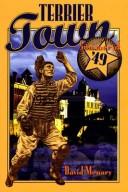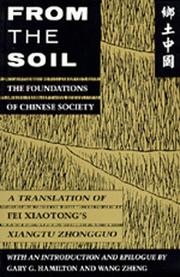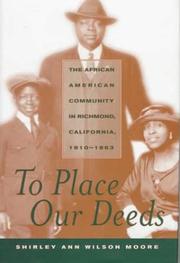| Listing 1 - 10 of 20 | << page >> |
Sort by
|
Book
ISBN: 1351201190 1351201174 1351201182 0815385420 0815391668 Year: 2018 Publisher: Boca Raton, FL : Routledge, an imprint of Taylor and Francis,
Abstract | Keywords | Export | Availability | Bookmark
 Loading...
Loading...Choose an application
- Reference Manager
- EndNote
- RefWorks (Direct export to RefWorks)
How can small cities make an impact in a globalizing world dominated by ‘world cities’ and urban development strategies aimed at increasing agglomeration? This book addresses the challenges of smaller cities trying to put themselves on the map, attract resources and initiate development. Placemaking has become an important tool for driving urban development that is sensitive to the needs of communities. This volume examines the development of creative placemaking practices that can help to link small cities to external networks, stimulate collaboration and help them make the most of the opportunities presented by the knowledge economy. The authors argue that the adoption of more strategic, holistic placemaking strategies that engage all stakeholders can be a successful alternative to copying bigger places. Drawing on a range of examples from around the world, they analyse small city development strategies and identify key success factors. This book focuses on the case of ‘s-Hertogenbosch, a small Dutch city that used cultural programming to link itself to global networks and stimulate economic, cultural, social and creative development. It advocates the use of cultural programming strategies as a more flexible alternative to traditional top-down planning approaches and as a means of avoiding copying the big city.
small town --- image --- development plan --- economic development --- artistic creation --- cultural policy --- collaborative economy --- public-private partnership --- knowledge economy --- public-private partnership. --- knowledge economy.
Book
ISBN: 150176134X 1501761544 Year: 2022 Publisher: Ithaca, New York : Cornell University Press,
Abstract | Keywords | Export | Availability | Bookmark
 Loading...
Loading...Choose an application
- Reference Manager
- EndNote
- RefWorks (Direct export to RefWorks)
"Scholars consider the present condition and future prospects of smaller US cities and towns struggling in the face of broad economic and social change. They offer a mix of ground-level analyses and more general examinations of the successes and failures of recent redevelopment policies and offer concrete ideas for local leaders engaged in redevelopment work"--

ISBN: 1771122153 1597347167 1282355112 9786612355110 0520935896 9780520935891 0585468486 9780585468488 9781597347167 9781282355118 9780520229587 0520229584 9780520229594 0520229592 0520229584 0520229592 9781771122153 6612355115 Year: 2002 Publisher: Berkeley, CA University of California Press
Abstract | Keywords | Export | Availability | Bookmark
 Loading...
Loading...Choose an application
- Reference Manager
- EndNote
- RefWorks (Direct export to RefWorks)
This beautifully written book weaves reflections on anthropological fieldwork together with evocative meditations on a spectacular landscape as it takes us to the remote indigenous villages on the shore of Lake Titicaca, high in the Peruvian Andes. Ben Orlove brings alive the fishermen, reed cutters, boat builders, and families of this isolated region, and describes the role that Lake Titicaca has played in their culture. He describes the landscapes and rhythms of life in the Andean highlands as he considers the intrusions of modern technology and economic demands in the region. Lines in the Water tells a local version of events that are taking place around the world, but with an unusual outcome: people here have found ways to maintain their cultural autonomy and to protect their fragile mountain environment. The Peruvian highlanders have confronted the pressures of modern culture with remarkable vitality. They use improved boats and gear and sell fish to new markets but have fiercely opposed efforts to strip them of their indigenous traditions. They have retained their customary practice of limiting the amount of fishing and have continued to pass cultural knowledge from one generation to the next--practices that have prevented the ecological crises that have followed commercialization of small-scale fisheries around the world. This book--at once a memoir and an ethnography--is a personal and compelling account of a research experience as well as an elegantly written treatise on themes of global importance. Above all, Orlove reminds us that human relations with the environment, though constantly changing, can be sustainable.
SOCIAL SCIENCE / Anthropology / Cultural & Social. --- Titicaca Lake Region (Peru and Bolivia) --- Description and travel. --- Social life and customs. --- andean highlands. --- andes mountains. --- anthropology. --- cultural history. --- cultural studies. --- culture. --- economics. --- economy. --- environment. --- ethnography. --- fieldwork. --- fishing. --- geography. --- global. --- highlands. --- indigenous people. --- indigenous villages. --- lake titicaca. --- landscape. --- meditation. --- memoir. --- modern world. --- natural world. --- nature. --- peru. --- peruvian mountains. --- peruvian. --- regional. --- small town. --- sustainability. --- technology. --- true story. --- villagers.

ISBN: 1771121300 1280925779 9786610925773 0889206872 9780889206878 9780889204270 Year: 2003 Publisher: [Waterloo, Ont.] [Place of publication not identified] Wilfred Laurier University Press
Abstract | Keywords | Export | Availability | Bookmark
 Loading...
Loading...Choose an application
- Reference Manager
- EndNote
- RefWorks (Direct export to RefWorks)
Debate still rages on about who invented baseball. But one thing is certain...it was alive and fractious in southwestern Ontario in the summer of 1949. It was a remarkable summer. For Charlie Hodge, just finishing his last year of high school, the summer of 1949 begins with great fanfare and excitement. He has made the Galt Terriers' roster and will be riding the bench with a star-studded team, many of whom had played with the major leagues. When those seasoned pros arrive in town, big things are expected, and they don't disappoint. There is the towering home run that Goody Rosen
Galt Terriers (Équipe de base-ball) --- Galt Terriers (Baseball team) --- Baseball stories, Canadian --- Baseball teams --- Fiction. --- Dickson Park. --- Galt Terriers. --- Larry Pennell. --- Walter Gretzky. --- Wayne Gretzky. --- baseball fiction. --- baseball hall of fame. --- baseball history. --- baseball in Canada. --- baseball in Ontario. --- baseball stories. --- inter-county baseball. --- small town baseball. --- southwestern Ontario baseball. --- sports fiction. --- Canadian fiction.
Book
ISBN: 9780520966475 0520966473 9780520293304 0520293304 9780520293311 0520293312 Year: 2017 Publisher: Berkeley, CA : University of California Press,
Abstract | Keywords | Export | Availability | Bookmark
 Loading...
Loading...Choose an application
- Reference Manager
- EndNote
- RefWorks (Direct export to RefWorks)
In this moving and insightful work, Deepak Singh chronicles his downward mobility as an immigrant to a small town in Virginia. Armed with an MBA from India, Singh can get only a minimum-wage job in an electronics store. Every day he confronts unfamiliar American mores, from strange idioms to deeply entrenched racism. Telling stories through the unique lens of an initially credulous outsider who is "fresh off the plane," Singh learns about the struggles of his colleagues: Ron, a middle-aged African-American man trying to keep his life intact despite health concerns; Jackie, a young African-American woman diligently attending school after work; and Cindy, whose matter-of-fact attitude helps Deepak adapt to his job and his new life. How May I Help You? is an incisive take on life in the United States and a reminder that the stories of low-wage employees can bring candor and humanity to debates about work, race, and immigration.
Foreign workers --- Working poor --- Immigrants --- Poor --- Working class --- Economic conditions. --- Employment --- United States --- african american. --- american history. --- black americans. --- career. --- careers. --- co workers. --- colleagues. --- community. --- culture. --- electronics. --- emotional. --- immigrant story. --- immigrant. --- immigration. --- indian culture. --- indian immigrant. --- jobs. --- low wage. --- minimum wage. --- motivational. --- new life. --- race issues. --- race. --- racism. --- racist. --- retail. --- small town. --- starting over. --- true story. --- united states. --- virginia. --- workplace issues. --- workplace.
Book
Year: 2018 Publisher: New York : Berghahn Books,
Abstract | Keywords | Export | Availability | Bookmark
 Loading...
Loading...Choose an application
- Reference Manager
- EndNote
- RefWorks (Direct export to RefWorks)
This ethnography of personhood in post-genocide Rwanda investigates how residents of a small town grapple with what kinds of persons they ought to become in the wake of violence. Based on fieldwork carried out over the course of a decade, it uncovers how conflicting moral demands emerge from the 1994 genocide, from cultural contradictions around “good” personhood, and from both state and popular visions for the future. What emerges is a profound dissonance in town residents’ selfhood. While they strive to be agents of change who can catalyze a new era of modern Rwandan nationhood, they are also devastated by the genocide and struggle to recover a sense of selfhood and belonging in the absence of kin, friends, and neighbors. In drawing out the contradictions at the heart of self-making and social life in contemporary Rwanda, this book asserts a novel argument about the ordinary lives caught in global post-conflict imperatives to remember and to forget, to mourn and to prosper.
Self --- Collective memory --- National characteristics, Rwandan. --- Reconciliation. --- Social aspects --- Rwanda --- Butare (Rwanda) --- History --- Peace. --- Social conditions --- 1990s world history. --- biographical. --- ethnographic. --- ethnography. --- mourn. --- murdered. --- nationhood. --- personhood. --- post conflict society. --- prosper. --- psychology. --- recovery. --- rhetoric. --- rwanda genocide. --- rwandans. --- selfhood. --- small town. --- social life. --- sociology. --- victims of violence.
Book
ISBN: 9786612357213 1282357212 0520930282 Year: 2001 Publisher: Berkeley, CA : University of California Press,
Abstract | Keywords | Export | Availability | Bookmark
 Loading...
Loading...Choose an application
- Reference Manager
- EndNote
- RefWorks (Direct export to RefWorks)
Twenty-five years ago Philip L. Fradkin read a book about a remote bay on the Gulf of Alaska coast. The noted environmental historian was attracted by the threads of violence woven through the natural and human histories of Lituya Bay. Could these histories be related, and if so, how? The attempt to define the power of this wild place was a tantalizing and, as it turned out, dangerous quest. This compelling and eerie memoir tells of Fradkin's odyssey through recorded human history and eventually to the bay itself, as he explores the dark and unyielding side of nature. Natural forces have always dominated Lituya Bay. Immense storms, powerful earthquakes, huge landslides, and giant waves higher than the world's tallest skyscrapers pound the whale-shaped fjord. Compelling for its deadly beauty, the bay has attracted visitors over time, but it has never been mastered by them. Its seasonal occupants throughout recorded history-Tlingit Indians, European explorers, gold miners, and coastal fishermen seeking a harbor of refuge-have drowned, gone mad, slaughtered fur-bearing animals with abandon, sifted the black sand beaches for minute particles of gold, and murdered each other. Only a hermit found peace there. Then the author and his small son visited the bay and were haunted by a grizzly bear. As an environmental writer for the Los Angeles Times and western editor of Audubon magazine, Fradkin has traveled from Tierra del Fuego to the North Slope of Alaska. But nothing prepared him for Lituya Bay, a place so powerful it turned one person's hair white. This story resonates with echoes of Melville, Poe, and Conrad as it weaves together the human and natural histories of a beautiful and wild place.
Violence --- Natural disasters --- Natural history --- History. --- Fradkin, Philip L. --- Travel --- Lituya Bay Region (Alaska) --- alaska. --- animals. --- coastal. --- environmental history. --- environmental. --- explorers. --- fishing. --- fjords. --- gold mining. --- gulf of alaska. --- historian. --- human history. --- indians. --- indigenous people. --- lituya bay. --- memoir. --- natural features. --- natural history. --- natural world. --- nature. --- northern united states. --- settlers. --- small town. --- tourism. --- tourists. --- true story. --- violence. --- visitors. --- western united states. --- world history.

ISBN: 0520083423 0520083415 0520914120 1280079959 9786613520203 0585132186 9780520914124 9780585132181 9780520083424 9781280079955 9780520083417 Year: 1994 Publisher: Berkeley : University of California Press,
Abstract | Keywords | Export | Availability | Bookmark
 Loading...
Loading...Choose an application
- Reference Manager
- EndNote
- RefWorks (Direct export to RefWorks)
Fascinating in its combination of personal stories and analytical insights, Some Trouble with Cows will help students of conflict understand how a seemingly irrational and archaic riot becomes a means for renegotiating the distribution of power and rights in a small community. Using first-person accounts of Hindus and Muslims in a remote Bangladeshi village, Beth Roy evocatively describes and analyzes a large-scale riot that profoundly altered life in the area in the 1950's. She provides a rare glimpse into the hearts and minds of the participants and their families, while touching on a range of broader issues that are vital to the sociology of communities in conflict: the changing meaning of community; the impact of the state on local society; the nature of memory; and the force of neighborly enmity in reshaping power relationships during periods of change. Roy's findings illustrate important theoretical issues in psychology and sociology, and her conclusions will greatly interest students of ethnic/race relations, conflict resolution, the sociology of violence, agrarian society, and South Asia.
Communalism -- Bangladesh. --- Hindus -- Bangladesh. --- Muslims -- Bangladesh. --- Communalism --- Hindus --- Muslims --- South Asia --- Regions & Countries - Asia & the Middle East --- History & Archaeology --- Mohammedans --- Moors (People) --- Moslems --- Muhammadans --- Musalmans --- Mussalmans --- Mussulmans --- Mussulmen --- Religious adherents --- Islam --- Hindoos --- 1950s. --- agrarian society. --- analysis. --- asian history. --- bangladesh. --- community. --- conflict resolution. --- conflict. --- distribution of power. --- ethnicity. --- first person. --- hindu. --- interview. --- memory. --- muslim. --- neighbors. --- power structure. --- psychology. --- race relations. --- religion. --- religious studies. --- revolution. --- riot. --- small town. --- social change. --- sociology. --- south asia. --- true story. --- violence.

ISBN: 0520077962 9780520912489 0520912489 0585104360 9780585104362 0520077954 9780520077959 1282134167 9786613806741 Year: 1992 Publisher: Berkeley (Calif.) : University of California press,
Abstract | Keywords | Export | Availability | Bookmark
 Loading...
Loading...Choose an application
- Reference Manager
- EndNote
- RefWorks (Direct export to RefWorks)
This classic text by Fei Xiaotong, China's finest social scientist, was first published in 1947 and is Fei's chief theoretical statement about the distinctive characteristics of Chinese society. Written in Chinese from a Chinese point of view for a Chinese audience, From the Soil describes the contrasting organizational principles of Chinese and Western societies, thereby conveying the essential features of both. Fei shows how these unique features reflect and are reflected in the moral and ethical characters of people in these societies. This profound, challenging book is both succinct and accessible. In its first complete English-language edition, it is likely to have a wide impact on Western social theorists. Gary G. Hamilton and Wang Zheng's translation captures Fei's jargonless, straightforward style of writing. Their introduction describes Fei's education and career as a sociologist, the fate of his writings on and off the Mainland, and the sociological significance of his analysis. The translators' epilogue highlights the social reforms for China that Fei drew from his analysis and advocated in a companion text written in the same period.
S11/0480 --- S20/0200 --- China: Social sciences--Rural life, rural studies: general and before 1949 --- China: Agriculture forestry, fishery, natural disasters--General works and before 1949 (incl. traditional Chinese works and the Yueling) --- China --- Social conditions. --- SOCIAL SCIENCE / Sociology / General. --- 1940s. --- academic. --- analysis. --- asia. --- asian countries. --- asian. --- china. --- chinese history. --- chinese society. --- community. --- confucius. --- countryside. --- cultural studies. --- ethics. --- gender studies. --- interpersonal. --- legal issues. --- morals. --- relationships. --- rural. --- scholarly. --- small town. --- social science. --- social scientist. --- social studies. --- social theory. --- sociology. --- translation. --- western world.

ISBN: 0520927125 0585283117 9780520927124 9780585283111 0520215656 Year: 2000 Publisher: Berkeley University of California Press
Abstract | Keywords | Export | Availability | Bookmark
 Loading...
Loading...Choose an application
- Reference Manager
- EndNote
- RefWorks (Direct export to RefWorks)
To Place Our Deeds traces the development of the African American community in Richmond, California, a city on the San Francisco Bay. This readable, extremely well-researched social history, based on numerous oral histories, newspapers, and archival collections, is the first to examine the historical development of one black working-class community over a fifty-year period.Offering a gritty and engaging view of daily life in Richmond, Shirley Ann Wilson Moore examines the process and effect of migration, the rise of a black urban industrial workforce, and the dynamics of community development. She describes the culture that migrants brought with them—including music, food, religion, and sports—and shows how these traditions were adapted to new circumstances. Working-class African Americans in Richmond used their cultural venues—especially the city's legendary blues clubs—as staging grounds from which to challenge the racial status quo, with a steadfast determination not to be "Jim Crowed" in the Golden State.As this important work shows, working-class African Americans often stood at the forefront of the struggle for equality and were linked to larger political, social, and cultural currents that transformed the nation in the postwar period.
African Americans --- Afro-Americans --- Black Americans --- Colored people (United States) --- Negroes --- Africans --- Ethnology --- Blacks --- History --- Black people --- Richmond (Calif.) --- Race relations. --- academic. --- african american communities. --- african american. --- archival. --- bay area. --- black communities. --- case study. --- community. --- cultural history. --- factory workers. --- industrial. --- jim crow. --- migration. --- minorities. --- minority. --- music. --- newspaper. --- oral history. --- political. --- politics. --- race issues. --- race. --- racism. --- religion. --- research. --- san francisco bay. --- san francisco. --- scholarly. --- small town. --- social history. --- traditional. --- water. --- working class.
| Listing 1 - 10 of 20 | << page >> |
Sort by
|

 Search
Search Feedback
Feedback About UniCat
About UniCat  Help
Help News
News